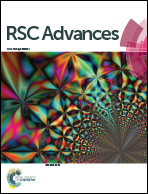One-step transformation of Cu to Cu2O in alkaline solution†
Abstract
Cu can be directly transformed to Cu2O before forming CuO in high concentration NaOH aqueous solution by facile surface oxidation reaction without additional oxidant. By using different Cu substrates, pure Cu2O films with different dominant facets can be obtained.


 Please wait while we load your content...
Please wait while we load your content...